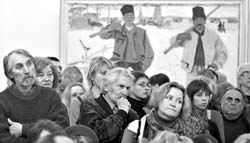A legend called Tetiana Yablonska

The National Art Museum of Ukraine has opened a high-profile retrospective exhibit to mark the 90th birth anniversary of the great master of painting Tetiana Yablonska.
The artist’s paintings attract visitors in the State Tretiakov Gallery in Moscow, the State Russian Museum in St. Petersburg, the Dragon Museum in Taiwan, the Kyiv Museum of Russian Art, the art museums of Poltava, Zaporizhzhia and Kharkiv, and the Lviv Picture Gallery.
This is Ukraine’s first exposition of the painter’s works, which practically spans all her artistic lifetime. According to Liudmyla Kovalska, chief of the National Art Museum’s 20th-century department, “This exhibit, to be open until May 13, presents canvases, ranging from Yablonska’s earliest pictures, including two academic ones, to the pastel pictures the artist painted in the last years oh her life. Apart from the canvases supplied by many Ukrainian museums, the exhibit displays works from the artist’s studio, which have never or very rarely been exhibited before. What can be termed the exhibit’s star attraction and symbol is Yablonska’s self-portrait and such pictures as Youth and Life Is Going On, the figurative expression of eternity. For life goes on in spite of the weather outside and the events now underway in the surrounding world, and this exhibit can be also said to continue the artist’s creative path.”
The museum’s four halls display pictured collected from several museums of Ukraine and made available by Yablonska’s family. These oeuvres embrace an entire epoch in which the artist created her pieces - from practice sketches and early 1960s drawings in the spirit of the early 20th-century avant-garde to classic canvases Bread (1949) and Life Is Going On (1971), as well as the tender pastels that the artist painted in the last years of her life. Yablonska’s pictures always focused on the everyday life of ordinary people: daily routine scenes, portraits of family members, and self-portraits in a home surrounding. Yet the artist would take a special, unconventional, attitude to what surrounded her. This is reflected in her works: there is nothing artificial or phony in them.”
They all carry extraordinary warmth and the feeling of being delighted with the word’s beauty. This could only be done by a master who had gone through a life full of ordeals and hardships but still managed to retain and even rediscover the feeling of beauty and exaltation and describe this in flawless artistic forms.
Half a century ago Yablonska’s pictures catapulted her to worldwide fame. Critics still like to draw literary parallels to her pictures. For example, they called Bread “the novel of a picture,” while the canvas Morning, showing a girl against the backdrop of an open window, is associated with a “poem,” and A People’s Poem, which depicts life in the Ukrainian countryside, is “a people’s epic.” Her pictures resemble haiku. Like Japanese miniatures, her canvases show an event which occurs in nature and is valuable in itself: for example, wandering clouds or a sunset as a sign of an immortal life and eternity.
Of special interest in the artist’s works are colors which speak in unison with other details of the picture but still express something of their own in a special language that only they can speak. They are organic, immaterial, solid and profound. The color conveys the spiritual substance of her works and is their main component.
Henri Matisse once said that “a painter is the one who has created at least one sign.” Yablonska did at least three sign-loaded things in her lifetime. They served as a role model, while the artist went on.






